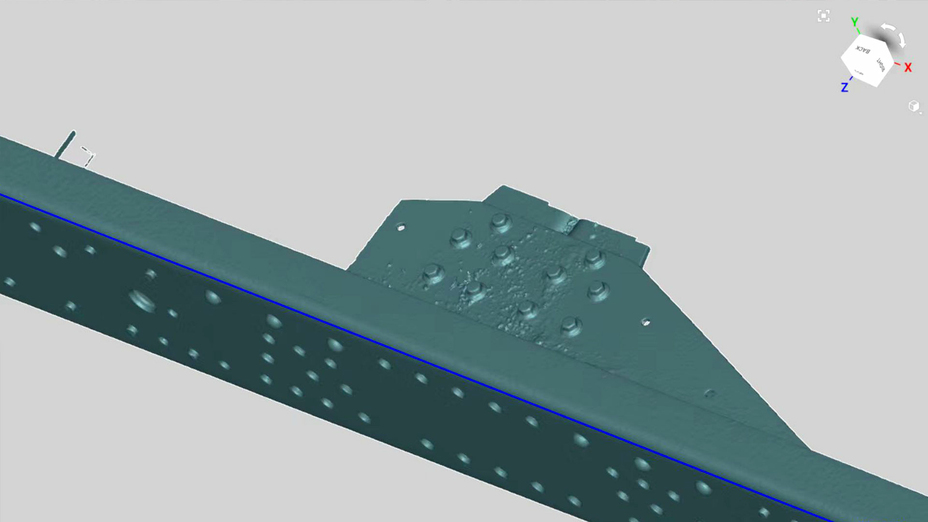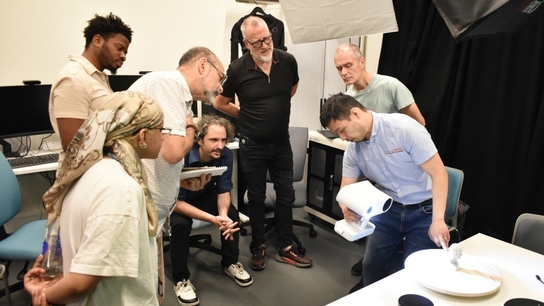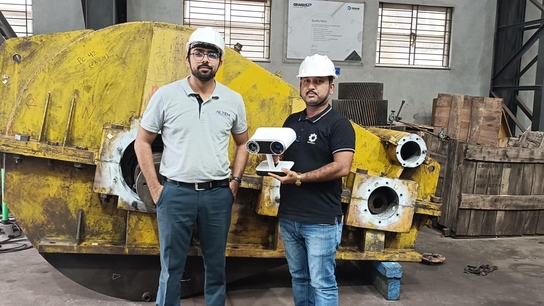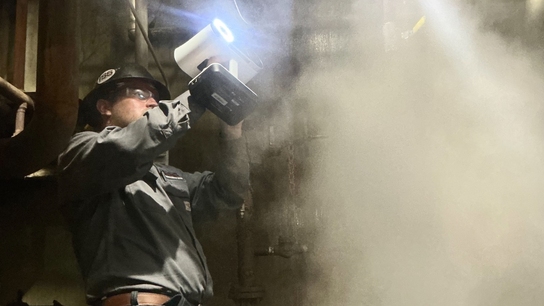Digitization makes truck repair less risky and 10x more efficient
Challenge: In order to repair truck beams, you need custom reinforced steel plates. Without CAD drawings, these have to be sized up with measuring tools in a laborious, time-consuming process that doesn’t guarantee accuracy.
Solution: Artec Leo, Artec Studio, Geomagic Design X
Result: Using Artec Leo, Yuyao Jiu Jiu Auto Repair is now able to accurately scan truck beams while measuring all the holes inside them, without needing any matte spray or targets. The firm then reverse engineers a parametric 2D drawing in Artec Studio and Geomagic Design X before exporting it to a laser machine for the creation of a custom repair plate.
Why Artec 3D? As it’s 100% wireless, Artec Leo is compact enough for effortless use in a maintenance shop. It’s also easy to pick up for beginners, with a touchscreen for progress tracking, and features a capture speed that makes key data collection ten times faster.

Busy trucks queueing up
Since they entered mass production in the early 20th century, cars have become essential to our daily transportation, and trucks – or lorries – are now an indispensable part of modern shipping and social development.
As of November 2022, China had 7.5 million certified trucks and over 20 million truck drivers, accounting for three quarters of freight traffic, and one third of everything on China’s roads.
However, this proliferation of truck traffic has brought human and economic casualties with it. Truck accidents are more likely, and they have even worse consequences than ordinary car crashes, due to their heavy loads and blind spots. With this in mind, the best way to avoid loss of life is to prevent such accidents from happening at all.
Anyone who understands general truck structure knows how important the truck beam or ‘frame’ is to vehicle safety. For the uninitiated, these beams are mounted to wheels near the front and rear axles of a truck’s suspension, and they carry almost all its accumulated weight.
Mostly made of high-strength plating, these beams are integrated in vertical and horizontal formations to create a steel structure connected through riveting. When implemented properly, they make trucks strong enough to resist load or wheel impacts, and they tend not to deform or become damaged unless involved in an accident.
In cases where beams do deform, due to topple-over, imbalanced loads, or lack of servicing, the truck will need to be sent to a garage for beam correction, strengthening, or replacement.

Truck beam
Chinese firm Yuyao Jiu Jiu Auto Repair specializes in the production of automotive spare parts and replacement bodies, and to date, it has repaired over 2,100 lorries.
As longitudinal and cross truck beams are mostly held together by riveting, Jiu Jiu mechanics can straighten out any deformities with a hydraulic press. Due to fracture and metal fatigue, high-strength steel plates also need to be added to both the inside and outside of beams, to make them stronger and safer.
All of this requires cutting, welding, and riveting – to hold custom parts in place. However, neither Jiu Jiu nor its clientele have access to the original CAD data behind truck parts. The traditional way to reverse engineer near them is to calculate the position of rivet holes with auxiliary tools, before drilling hundreds of holes into a custom plate with a rocker drill.
But since these huge beams have many holes of different sizes, the reinforced plate can be as long as a dozen meters. The whole process is laborious, time-consuming, and doesn’t guarantee accuracy. What’s more, if the hole positions are measured incorrectly and need adjusting, this extends the length of repair times even further.

Artec Leo being used to 3D scan a truck beam (Courtesy of FLD-TECH, Ningbo)
Having learned of Artec 3D’s scanning technology, the company’s leadership team recently began experimenting with using it to collect beam repair data, and approached Artec 3D Gold-certified partner FLD-TECH in Ningbo, China, to find out more.
Given the conditions and data requirements of their application, FLD-TECH engineers recommended Artec Leo as the best solution. Once on-site, the wireless, AI-powered device proved capable of scanning entire beams within half an hour, with no additional preparation or laptop required.
Engineers just needed to direct the scanner and ensure they’d captured the whole beam using its built-in touchscreen, in a process that provided a significant boost to their efficiency.
Data was then fed from the scanner to Artec Studio, where a complete 3D model could be generated that included highly accurate information about all the beam’s holes. Intuitive and easy to use, the program features an Autopilot that automates data processing, by selecting the most effective algorithm for a given project based on just a few inputs.
Artec Studio’s unique AI Neural Engine also allows for the capture of thin objects with sharp edges in high resolution, in a way that made reverse engineering a breeze for Jiu Jiu’s team.

Processing in Artec Studio: Truck beam data collected with Artec Leo (I)

Processing in Artec Studio: Truck beam data collected by Artec Leo (II)

Processing in Artec Studio: Truck beam data collected by Artec Leo (III)
After processing in Artec Studio, data could then be exported to Geomagic Design X for the reverse engineering of a parametric model and generation of parametric 2D drawings.

A parametric model generated using a reverse-engineered model in Geomagic Design X
The last step in the process saw the engineers export their parametric model to a laser machine, with which they could cut holes into a custom steel plate automatically.
Having been through the whole process, Jiu Jiu is said to be very pleased, as it requires less labor and yields more accurate holes than before. During riveting, it found that all the holes matched perfectly, meaning there were no reworking or maintenance costs either.

Reinforced steel plate after installation (outside), Image courtesy of Jiu Jiu

Reinforced steel plate after installation (inside), Image courtesy of Jiu Jiu
“Artec Leo has greatly improved our repair efficiency, and we are trying to expand its use in other applications to help with other business,” said Wu Fuqiang, founder of Jiu Jiu. “In manufacturing, especially in the field of reverse engineering, Artec 3D helps its clients achieve their expected goals with its comprehensive, easy-to-use, quality solutions.”
Scanners behind the story
Try out the world's leading handheld 3D scanners.





